Bible prophecy: Revelation: Book of Cosmic Symbols
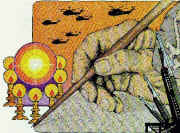 To understand Revelation it is helpful to think of this writing as first and foremost a book of symbols. For example, we see the victorious Christ, riding on a horse (19:11-16). He wields a sword with which he smites the nations. That picture is symbolic of an event and divine power — the return of the Messiah, who destroys the forces of evil.
To understand Revelation it is helpful to think of this writing as first and foremost a book of symbols. For example, we see the victorious Christ, riding on a horse (19:11-16). He wields a sword with which he smites the nations. That picture is symbolic of an event and divine power — the return of the Messiah, who destroys the forces of evil.
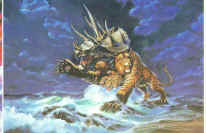 Revelation’s symbols are often juxtaposed one against another. This use of comparison and contrast is seen throughout the book. In the middle chapters of Revelation, Satan’s forces — the beast and false prophet — are pitted against God’s earthly representative, the church. The book describes two ages of human existence, each contrary to the other. Satan, the dragon, is the remorseless adversary of God, and dominates this present world. Jesus Christ, the Lamb of God, rules a world of peace, popularly known as the millennium.
Revelation’s symbols are often juxtaposed one against another. This use of comparison and contrast is seen throughout the book. In the middle chapters of Revelation, Satan’s forces — the beast and false prophet — are pitted against God’s earthly representative, the church. The book describes two ages of human existence, each contrary to the other. Satan, the dragon, is the remorseless adversary of God, and dominates this present world. Jesus Christ, the Lamb of God, rules a world of peace, popularly known as the millennium.
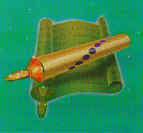 Revelation portrays and compares two opposing ways of life. Two symbols embody these conflicting lifestyles. A harlot pictures the deceived group, deluded by what’s called her “spiritual fornication.” This refers to her illicit spiritual liaisons with political rulers. Another group of people follows the Lamb, who is Jesus. These are called the spiritually pure Bride of Christ.
Revelation portrays and compares two opposing ways of life. Two symbols embody these conflicting lifestyles. A harlot pictures the deceived group, deluded by what’s called her “spiritual fornication.” This refers to her illicit spiritual liaisons with political rulers. Another group of people follows the Lamb, who is Jesus. These are called the spiritually pure Bride of Christ.
The image of an enormous metropolis — Babylon the Great — stands for the corrupt system that seduces the world. Revelation contrasts this wicked city with the purity and perfection of the New Jerusalem. Ultimately, the latter stands for the ideal and eternal congregation of those who are faithful to Christ.
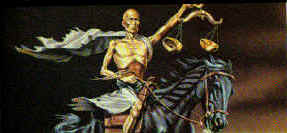 Even the promise to share in salvation is represented by this – worldly symbols. This use of symbolism occurs in the seven letters to Christian congregations in the province of Asia. For example, the church in Ephesus is promised salvation by being told it will have “the right to eat from the tree of life” (2:7). That is a metaphor for salvation and eternal life.
Even the promise to share in salvation is represented by this – worldly symbols. This use of symbolism occurs in the seven letters to Christian congregations in the province of Asia. For example, the church in Ephesus is promised salvation by being told it will have “the right to eat from the tree of life” (2:7). That is a metaphor for salvation and eternal life.
Norman Perrin clearly outlined this dualistic and symbolic structure of Revelation in which the spiritual realm, the church, and the world system are given their parts to play. He wrote:
At the pinnacle of power on one side is God, the Pantocrator, ruler of all (1:8). On the other is Satan, the Dragon, who has power, a throne, and great authority (13:2). Allied with God is the Lamb who was slain (5:6)…. Allied with Satan is the beast from the sea (13:1-2). . . .All the people on the earth are divided into two groups; those who have the seal of God on their foreheads and whose names are in the book of life (3:5, 12; 7:3; 20:4; 21:27; 22:4) and those who bear the mark of the beast and worship it (9:4; 13:8, 17; 14:9-11; 16:2; 20:15). There is also a sharp contrast between the luxurious and voluptuous harlot, who represents Babylon, the earthly city of abominations (ch.17) and the pure bride of the Lamb, who symbolizes Jerusalem, the heavenly city of salvation (19:7-8; 21: 2, 9-11). This literary tension reflects the political tension between the adherents of the kingdom of God and those of the kingdom of Caesar (11:15; 12:10; 16:10; 17:18) (Jesus and the Language of the Kingdom, p. 142).
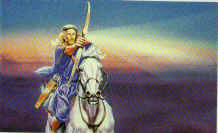 To the modern western world, Revelation’s symbols seem weird and alien. They include a multi-headed dragon; two strange beasts; a city shaped like a cube 1,500 miles high, wide and long; marks on heads and right hands; a figure’s mouth with a sword emerging from it, and so on.
To the modern western world, Revelation’s symbols seem weird and alien. They include a multi-headed dragon; two strange beasts; a city shaped like a cube 1,500 miles high, wide and long; marks on heads and right hands; a figure’s mouth with a sword emerging from it, and so on.
These symbols were not strange to John’s original audience for whom the book was written. Revelation drew on commonly known pagan myths, Old Testament and Jewish typologies, as well as New Testament Christian traditions and beliefs. These symbols were generally understood to refer to spiritual truths and historical realities. For example, in the Roman world of John’s time there were various stories about a god of heaven slaying the sea monster.
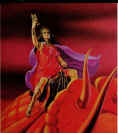 Some of Revelation’s symbols played off of such myths circulating in the pagan world. However, the book’s symbols are heavily based on Old Testament themes, which in turn had been reinterpreted by Jewish apocalyptic literature.
Some of Revelation’s symbols played off of such myths circulating in the pagan world. However, the book’s symbols are heavily based on Old Testament themes, which in turn had been reinterpreted by Jewish apocalyptic literature.
In Revelation, the meanings of symbols existing in the Jewish and pagan world were again reinterpreted in the light of the Christian’s experience in Christ. The point is that the symbols were not strange codes that one had to have special knowledge to understand. It’s safe to say John’s readers knew what he meant. In the words of G. B. Caird:
The first readers were almost certainly well versed in the sort of symbolic language and imagery in which the book is written. Whether they had formerly been Jews or pagans, they would read the language of myth as fluently as any modern reader of the daily papers reads the conventional symbols of a political cartoon. Much of this language we can reconstruct for ourselves from the Old Testament and Jewish apocalyptic writings on the one hand and from Greek and Roman literature, inscriptions, and coinage on the other (Black’s New Testament Commentaries, “A Commentary on the Revelation of St. John the Divine,” 2nd edition, p. 6).
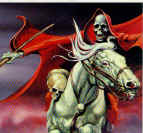 This makes sense if we consider a type of modern graphic genre, the political cartoon. G. R. Beasley-Murray calls the political cartoon “the closest modern parallel” to Revelation’s symbols (The New Century Bible Commentary, “Revelation,” p. 17).
This makes sense if we consider a type of modern graphic genre, the political cartoon. G. R. Beasley-Murray calls the political cartoon “the closest modern parallel” to Revelation’s symbols (The New Century Bible Commentary, “Revelation,” p. 17).
Political cartoons use stereotyped images. Beasley-Murray gives some examples of modern cartoon symbols. Two examples are John Bull, who represents the temper of Britain, and Uncle Sam, the spirit of the United States. The lion also represents Britain and the eagle the United States. Two other symbols are the bear for Russia and the dragon for China.
Often these and other political figures are drawn as caricatures. Says Beasley-Murray, “Frequently the situations depicted are deliberately exaggerated, and even made grotesque, in order that the message may be made plain” (The New Century Bible Commentary, “Revelation,” p. 17). The operative word here is plain. That’s what the symbols of Revelation were to John’s congregations. They were plain, simple and quickly understood. Beasley-Murray explains the point further:
The symbols by which the contemporary political forces and the spiritual powers of heaven and hell are portrayed [in Revelation] were as traditional as Britannia and the British lion, the Russian bear, and the Chinese dragon…. What to the uninitiated modern reader appears grotesque imagery, spoke with power to John’s fellow Christians (The New Century Bible Commentary, p. 17).
Most people are familiar with George Orwell’s Animal Farm, in which animals speak. The book itself is a political-social statement about the excesses of political leadership and the subjugation of the weak. We do not think the book bizarre because animals talk in it. We know it is symbolic. We also readily understand the meaning of Orwell’s symbols — and enjoy them. In fact, it was precisely because of the form in which Animal Farm was written that has made it a timeless piece of literature.
There are several lessons in this for us. First, we should not consider Revelation strange or bizarre. The book was probably easy to understand, extremely interesting and thoroughly meaningful to the original readers. If we can put ourselves in their place, this biblical writing can be all these things to us as well.
Second, we should not force Revelation’s symbols into a literal mode. If the book is a kind of painting of God’s purpose, it is much more expressionistic or impressionistic than realistic. In the words of George Eldon Ladd: “Apocalyptic language does not convey its message in precise photographic style, but more in the style of modern surrealistic art with great fluidity and imagination” (A Commentary on the Revelation of John, p. 111). Ladd explains that Revelation’s symbols are “not meant to be photographs of objective facts; they are often symbolic representations of almost unimaginable spiritual realities,” p. 102.
M. Eugene Boring explains it this way:
Many of the scenes John describes simply cannot be imaged. Not only can they not be placed on a canvas or movie screen, they cannot be placed on the screen of the mind. The vision of the exalted Christ in 1:12-16, for example, simply becomes grotesque if one attempts to understand it as a reporter’s account of what John actually saw in the objective world (Interpretation: A Bible Commentary for Teaching and Preaching, “Revelation,” p. 54).
Here Christ is pictured as speaking through a mouth out of which a sharp double-edged sword protrudes. If an attempt is made to understand the anthropomorphic picture of Christ in Revelation 1 as a literal representation of what he looks like, this part of the portrait admittedly is bizarre. The portrait becomes meaningful only if we understand John’s portrayal of the sword as a symbol of the sharpness and power of God’s word (Hebrews 4:12; Ephesians 6:17).
Of course, we need to be careful about overly allegorizing Revelation, as much as we need to avoid a strict literalism. As mentioned, this was probably not a difficulty John’s original readers faced. The knew the situation in which they lived and the meaning of the symbols. But we are divorced from both. In the words of G. B. Caird:
Our difficulties begin when we try to decide how far to take this picture language literally and how far to take it figuratively. When John echoes the Roman legend that the dead Nero was about to return, how literally does he mean it? Does he believe that Nero was not in fact dead, or that he would be resurrected, or that another paranoiac would come to fill his empty shoes? (Black’s New Testament Commentaries, “A Commentary on the Revelation of St. John the Divine,” 2nd edition. p. 7).
In one sense, these issues are only of historical importance, vital only to John’s original readers. But if that was all that Revelation’s symbols pictured — that is, events, situations and people in John’s day — they would have little meaning for us.
However, since Revelation uses symbols to represent spiritual realities, the book has universal meaning for all times and generations. Having said this, another caution is in order. We should not dismiss the historical context and meaning of the symbols, nor their possible application to specific situations and individuals. These, however, are not the primary meanings.
The point is, symbols can have different kinds of meaning. The symbol “bear” can have a simple meaning when referring to Russia. That is, bear = Russia. On another level, the bear says something about the kind of political power the nation embodies. On a third level, “bear,” already known to be symbolic of a lumbering political giant, can stand for all such empires—including perhaps the massive ancient Persian empire.
The American flag can be described as composed of 13 stripes and 50 stars. That is what the flag is, literally. It also is a symbol representing 13 original colonies and 50 states. The American flag also represents the nation. That is, when we see the flag, we think “United States.” But the American flag waving in the breeze during a patriotic parade represents something much more. It symbolizes a concept — a big idea — the pride of being an American.
In the same way, Revelation’s symbols can have various kinds and levels of meanings. Its symbols are not what are called “steno-symbols,” that is those that have only a single reference point. For example, if the symbol “bear” were such a symbol it could only be a nickname for the nation. But as we saw, the “bear” symbol has diverse meanings on several levels.
Revelation’s symbols are often what are called “tensive” symbols. They are open-ended to some degree in that they can represent several conceptions or ideas. For example, if the first beast of Revelation 13 can be identified with the city of Rome in John’s day, this does not exhaust its meaning. The tensive symbol “beast” may also represent the Roman Empire, or refer to a specific individual such as the emperor Nero or Domitian. “Beast” may also stand for all human empires that oppress Christians.
G. B. Caird is correct when he says that it is, “Misleading to say that in Revelation the monster is Rome, and still more misleading to say that it is ruler worship. The monster is both an older and a newer phenomenon than Caesar, and the great city is more ancient and more modern than Rome” (Black’s New Testament Commentaries, “A Commentary on the Revelation of St. John the Divine,” 2nd edition, p. xii).
It’s important to understand that Revelation speaks of concepts that deal with an ultimate reality about which we have no direct experience or knowledge. That’s why it uses symbols and why the book can indicate earthly and heavenly realities only in extremely rough outline.
To cite an example, God is pictured as sitting on a heavenly throne in Revelation. The throne represents, in symbol, to us who are limited to this physical world, the glory, the lordship and universal authority of God. Admittedly, the throne symbol is a rather poor reflection of God’s universal supremacy. But those are the limitations of human language and our experiential knowledge of God.
Some commentators suggest that the symbols Revelation used were not readily understood by those of John’s time. This idea claims John used coded language so that the criticism it contained of the Roman government would be kept secret from outsiders.
However, the average reader would have quite easily picked out the possible references to Rome. For example, Jews typically equated Rome with Babylon in apocalyptic writings. It was also common knowledge that Rome was the city built on seven hills. Both images are used in Revelation.
Assuming the Roman police were of at least average intelligence and could read, it hardly seems they would have missed this. M. Eugene Boring points out that the mere reference to God or Christ as king (11:15) would have clearly appeared subversive to Roman authorities.
On the other hand, only a small portion of Revelation’s material could be construed as applying to Rome. Then, if John’s use of symbolic material was meant to confound the Roman secret police, why is virtually all of the book written in symbolic, apocalyptic form?
Whatever the answer, John’s purpose is clearly stated: it is to reveal, not conceal. M. Eugene Boring points out: “With reference to the Roman government, John does not veil whom he means; he writes to reveal the essential nature of Roman power, which was not at all obvious to many members of John’s churches” (Interpretation: A Bible Commentary for Teaching and Preaching, “Revelation,” p. 55).
We must again remind ourselves that Revelation is not written as an attack against the outside world. It is written to be read in the church — the worshipful community of the saints. The book would not be that concerned with outsiders’ reactions.
But the book is not simply a straightforward letter such as a Colossians or 1 Peter. Revelation seeks to create a symbolic world for its readers and to put them into it. The book attempts to create for them the same wonder and awe that John experienced. In modern language, we might call Revelation a “virtual reality” experience. In the words of G. B. Caird:
John uses his allusions not as a code in which each symbol requires separate and exact translation, but rather for their evocative and emotive power. This is not photographic art. His aim is to set the echoes of memory and association ringing (Black’s New Testament Commentaries, “A Commentary on the Revelation of St. John the Divine,” 2nd edition, p. 26).
In conclusion, Revelation does not have as its primary purpose the aim of providing the curiosity seeker with information to bolster speculations about an apocalyptic “end-time.” The symbols in the book are meant to bring forth a response on the part of God’s people of continued faith in Jesus Christ as Lord of creation, the world and the church.
Author: Paul Kroll

